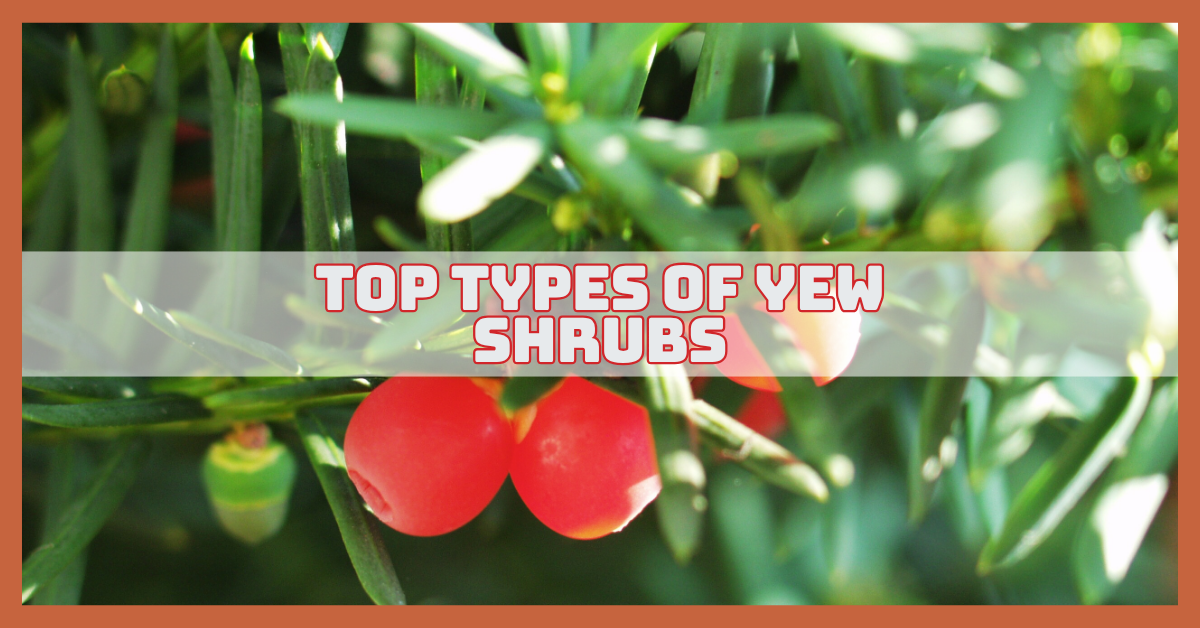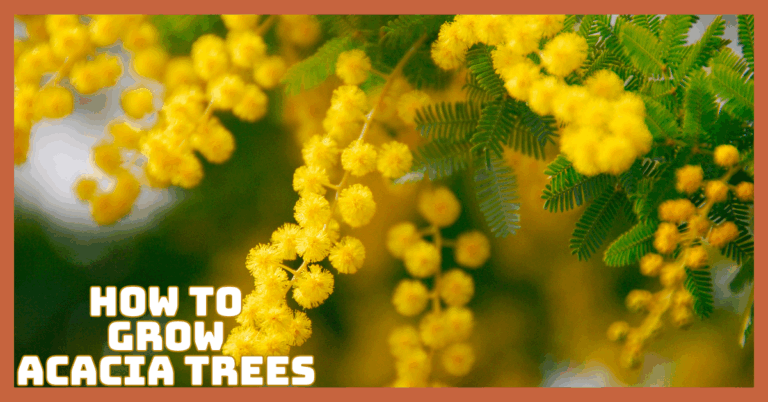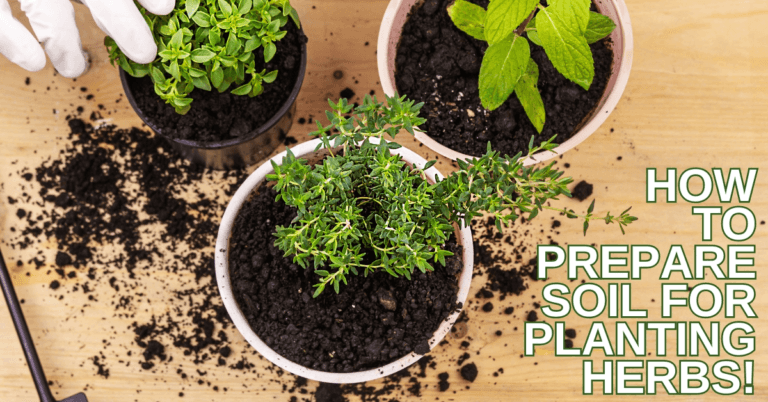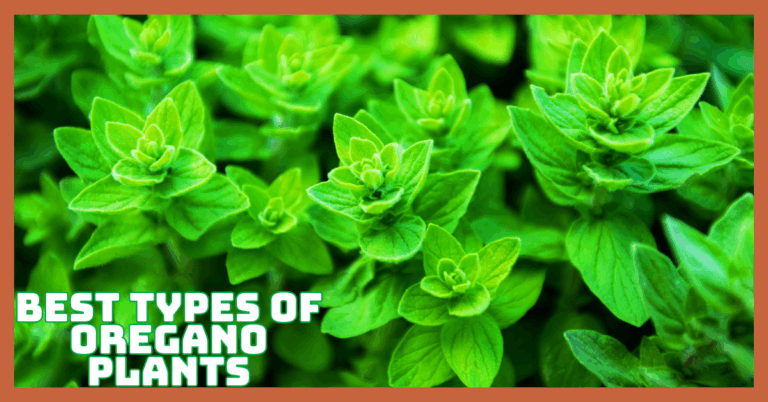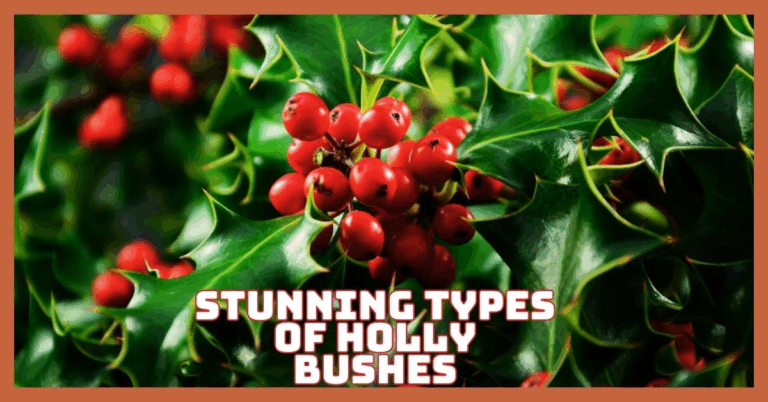Best Types Of Yew Shrubs That Will Transform Your Garden
Yew shrubs (genus Taxus) are some of the most versatile, long-lived, and elegant evergreen plants in the world. Admired for their lush, dark green needles, red berry-like arils, and refined appearance, yews are widely used in formal hedging, foundation planting, and topiary design.
Whether you're looking for a low-maintenance hedge, a statement specimen, or a compact shrub for a small space, there's a yew variety to suit your needs.
In this blog, we’ll explore the different types of yew shrubs, how to identify them, their ideal growing conditions, and tips for successful care.
Let’s dig into the world of these timeless conifers.
What Are Yew Shrubs?
Yew shrubs, belonging to the Taxus genus, are evergreen conifers admired for their dense, needle-like foliage and versatility in landscaping.
Originally from parts of Europe, Asia, and North America, these slow-growing plants are frequently employed for accent shrubs, hedges, topiary, and foundation plantings because of their versatility and graceful appearance.
Yews are a common choice in both formal and informal gardens since they grow well in a range of soil types and lighting situations, from full sun to deep shade.
The most common types include English yew (Taxus baccata), Japanese yew (Taxus cuspidata), and hybrid varieties like the Hicks yew.
Yews bear small, red, berry-like fruits that are visually striking, although toxic to humans and pets if ingested. Their tolerance to pruning allows gardeners to maintain precise shapes and sizes throughout the seasons.
With proper care, yew shrubs can live for decades—sometimes even centuries—offering timeless structure, year-round greenery, and a dignified presence to garden landscapes.
Why Choose Yew Shrubs?
Yews are incredibly adaptable and offer several landscape benefits:
1. Evergreen Beauty Year-Round
Yew shrubs retain their deep green foliage throughout the year, offering visual appeal even in the coldest months. Their lush, needle-like leaves provide structure and colour when other plants go dormant, enhancing the garden’s beauty every season.
2. Exceptional Longevity
Known for their remarkable lifespan, yews can live for several decades or even centuries with proper care. This makes them a long-term investment for landscapes, allowing homeowners to enjoy their presence and elegance for generations to come.
3. Highly Versatile
Yews can grow in a wide range of lighting conditions—from full sun to deep shade—making them adaptable to various parts of a garden. Their flexibility makes them suitable for mixed borders, foundation plantings, or formal and informal garden styles.
4. Easy To Prune And Shape
Their dense growth and forgiving nature make yews easy to prune into neat shapes or topiaries. Whether used for structured hedging or artistic sculpting, they respond well to trimming and can maintain a clean, polished look with minimal effort.
5. Low Maintenance
Once yews are established, they require very little care beyond occasional watering and trimming. They’re drought-tolerant and don’t demand frequent fertilizing, making them ideal for gardeners who want reliable greenery without constant upkeep or attention.
6. Excellent Windbreak Or Privacy Hedge
When planted close together, yews form thick, lush walls that serve as excellent windbreaks or privacy screens. Their dense foliage blocks wind, noise, and unwanted views, providing a quiet and sheltered atmosphere in both urban and rural spaces.
7. Adaptable To Various Soil Types
With proper drainage, yew shrubs can thrive in a range of soil types, including clay-heavy and sandy soils. Because of their versatility, they can be planted in a variety of settings without requiring major soil modifications or amendments.
Introducing Different Types Of Yew Shrubs
Yew shrubs are timeless evergreens valued for their dense foliage, adaptability, and elegant appearance. Found across the globe, different species offer unique traits suited to various climates and landscape needs.
Let’s explore the most popular types of yew shrubs:
1. English Yew (Taxus baccata)
- Also known as: Common Yew, European Yew
- Bloom time: Early spring
- Zones: USDA Zones 5–7
Features
The English Yew is a timeless evergreen shrub admired for its dense, dark green foliage and red, berry-like arils. It has a naturally conical shape, but is highly tolerant of pruning, making it ideal for formal hedges, topiaries, and screens.
Slow-growing yet long-lived, some specimens survive for centuries. This shrub adds year-round structure and elegance to landscapes and thrives in shaded or partially shaded spots.
Its foliage is toxic if ingested, but it remains a favorite among gardeners for its stately appearance, adaptability, and resilience in temperate climates.
How To Grow
USDA Zone 5–7 is where English Yew grows well. Though it loves well-drained soil and is partial to full shade, it may tolerate sun in cooler locations.
Once established, plants can withstand drought, but young seedlings need frequent watering. Since yews don't like moist roots, stay away from damp situations.
To preserve shape and promote dense growth, prune in the late winter or early spring. It prefers slightly acidic to neutral soil.
This hardy shrub is relatively low-maintenance, making it a popular choice for both formal gardens and natural hedges—regular mulching and occasional feeding support healthy, long-term growth.
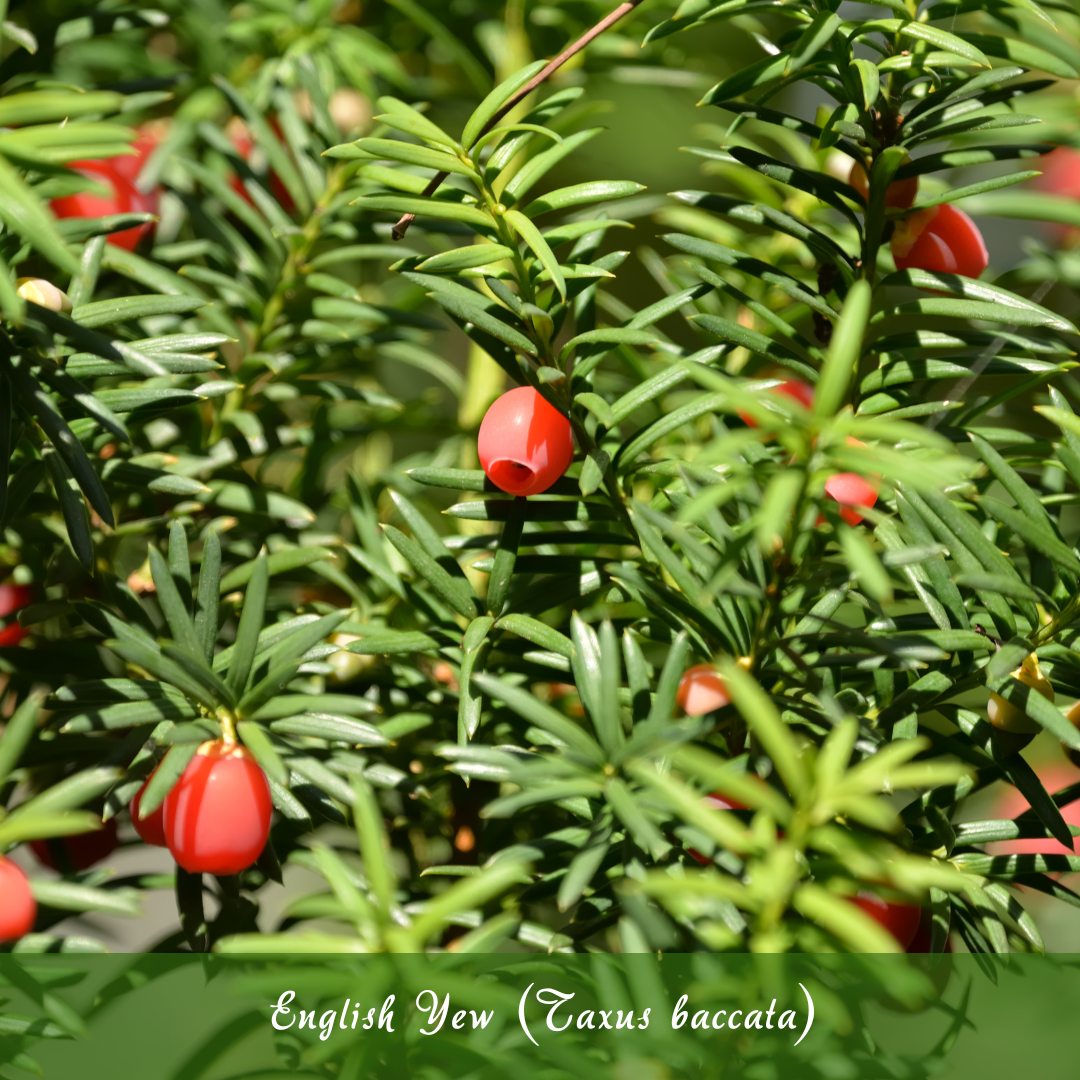
2. Japanese Yew (Taxus cuspidata)
- Also known as: Spreading Yew, Cuspidate Yew
- Bloom time: Early to mid-spring
- Zones: USDA Zones 4–7
Features
The Japanese Yew is a versatile evergreen shrub or small tree known for its upright to spreading form and finely textured, dark green needles.
It produces red, fleshy arils that add ornamental interest in late summer to fall. Its dense foliage makes it excellent for privacy hedges, foundation plantings, and topiary work.
Unlike many conifers, it tolerates pruning well and can be shaped into formal or informal designs. It’s hardy in colder climates and resistant to urban pollution.
For both residential and commercial landscaping, its stylish appearance, adaptability, and shadow tolerance make it a popular choice.
How To Grow
Japanese Yew grows best in USDA Zones 4–7. It prefers well-drained, fertile soil and can thrive in full sun to partial shade. While it tolerates some drought once established, it benefits from consistent watering during dry spells.
Avoid planting in waterlogged or heavy clay soils—mulch to retain moisture and protect roots. Prune in early spring to maintain the desired shape and remove dead or damaged branches.
This yew adapts well to both formal gardens and natural settings, offering year-round beauty with minimal maintenance when planted in suitable conditions.
Turn Your Passion for Nature Into Income
🌿 Whether you love gardening, caring for animals, or exploring holistic living,
You can share your knowledge online and earn from it.
Discover how nature lovers are growing their passions into meaningful, income-generating blogs. 👇
3. Anglo-Japanese Yew (Taxus × media)
- Also known as: Hybrid Yew, English-Japanese Yew
- Bloom time: Early spring
- Zones: USDA Zones 4–7
Features
The Anglo-Japanese Yew is one of the most versatile types of yew shrubs, prized for its dense foliage and adaptability. It features thick, dark green needles with a slightly glossy finish and produces bright red arils in late summer.
This shrub exhibits a variety of growth habits depending on the cultivar, ranging from upright columns to low, spreading forms. Its adaptability to pruning makes it ideal for hedges, screens, and foundation plantings.
Hardy and resilient, it thrives in various soils and light conditions, offering year-round greenery and architectural interest to landscapes.
How To Grow
USDA Zones 4–7 support the growth of Anglo-Japanese Yew. It prefers well-draining soil with a moderate moisture content and may tolerate full sun to light shade.
This yew is adaptable to different soil types but dislikes overly wet conditions. Regular watering is needed during establishment, but less so once mature. Prune in late winter or early spring to shape and encourage dense growth.
It is low-maintenance, pest-resistant, and suitable for formal hedging or naturalistic plantings, making it a versatile choice for many garden styles.
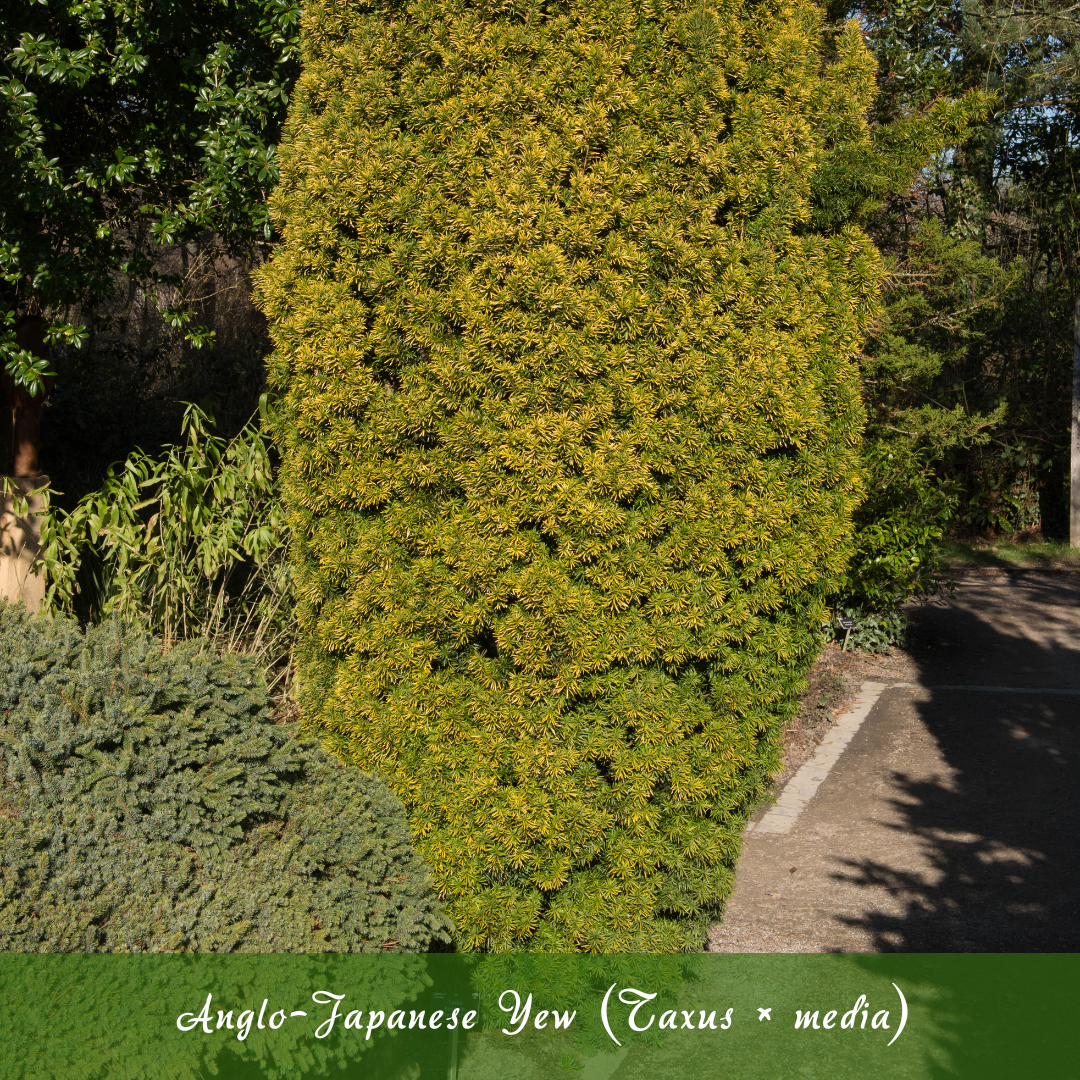
4. Western Yew (Taxus brevifolia)
- Also known as: Pacific Yew, Oregon Yew
- Bloom time: Early spring
- Zones: USDA Zones 5–8
Features
Western Yew is a slow-growing evergreen native to the Pacific Northwest. In late summer, it bears tiny crimson arils and has silky, dark green needles that appear somewhat flattened. Unlike many garden yews, it typically grows as a small tree or large shrub with a more natural, irregular form.
It thrives in cool, moist, shaded forest environments and is valued for its dense foliage and wood, which has medicinal significance. This species is less commonly used in formal landscaping but is ideal for woodland gardens and naturalized areas.
How To Grow
Western Yew grows best in USDA Zones 5–8, preferring cool, shaded, and moist environments typical of forest understories.
It thrives in well-drained, acidic to neutral soils rich in organic matter. Regular watering is essential during dry periods, especially when young.
Avoid planting in full sun or overly dry sites, as it prefers shade and consistent moisture. Minimal pruning is required, mainly to remove dead branches.
This yew is well-suited for naturalistic landscapes, shade gardens, or conservation areas where its native habitat can be mimicked.
5. Florida Yew (Taxus floridana)
- Also known as: St. Mary's Yew
- Bloom time: Early spring
- Zones: USDA Zones 6–8
Features
Among the rare types of yew shrubs, the Florida Yew is notable for its compact form, conservation importance, and delicate beauty in shaded environments. It has soft, dark green needles and a compact, slow-growing habit, typically forming a small, dense shrub.
This yew produces bright red arils in late summer, adding ornamental interest. Due to its limited natural range, it is often cultivated for conservation purposes.
The Florida Yew prefers cool, moist, shaded environments and adds subtle beauty to woodland gardens. Its rarity and delicate nature make it a unique addition to specialized collections.
How To Grow
Florida Yew grows best in USDA Zones 6–8 and requires consistently moist, well-drained, acidic soil rich in organic matter. It thrives in full to partial shade, mimicking its native forest understory habitat.
Regular watering is necessary to maintain moisture, especially during dry spells. Avoid full sun exposure and dry or compacted soils, as this can stress the plant.
Minimal pruning is needed, mostly to remove damaged or dead branches. Due to its endangered status, propagation and cultivation should be done responsibly to support conservation efforts.

6. Pacific Yew (Taxus canadensis)
- Also known as: Canadian Yew, Ground Hemlock
- Bloom time: Early spring
- Zones: USDA Zones 3–7
Features
Pacific Yew is a low-growing, spreading evergreen shrub native to northeastern North America. It features soft, flat, dark green needles and produces small red arils in late summer.
Unlike taller yews, it forms dense mats or groundcover, making it ideal for shady woodland gardens and naturalized areas.
Its slow growth and shade tolerance allow it to thrive under forest canopies. The Pacific Yew is valued both for its ecological role and as a source of the anti-cancer drug paclitaxel.
How To Grow
Pacific Yew thrives in USDA Zones 3–7, preferring cool, moist, and shady environments similar to its native woodland habitat. It grows best in acidic, well-drained soils rich in organic matter.
Regular watering is essential, especially in dry conditions, but avoid waterlogged soil. This shrub tolerates deep shade and thrives beneath trees or in shaded garden corners.
Minimal pruning is needed, primarily to maintain shape or remove dead wood. Pacific Yew is a low-maintenance plant, suitable for naturalistic landscapes and erosion control in shaded areas.
7. Himalayan Yew (Taxus wallichiana)
- Also known as: Thuner, Birmi
- Bloom time: Late spring to early summer
- Zones: USDA Zones 7–9
Features
Among the unique types of yew shrubs, the Himalayan Yew stands out for its tree-like form, medicinal value, and ornamental appeal.
Unlike many yews, it often grows as a small tree rather than a shrub, reaching up to 30 feet tall. It’s slow-growing and shade-tolerant, making it ideal for woodland gardens.
The plant is culturally significant and is also valued medicinally as a source of taxol, used in cancer treatments. Its ornamental appearance and adaptability to cooler highland climates make it an attractive choice for temperate gardens.
How To Grow
Best grown in USDA Zones 7–9, Himalayan Yew thrives in cool, moist, and partially shaded environments. It favours soil that is rich in organic materials, well-drained, and slightly acidic.
Consistent moisture is essential, especially during establishment, but avoid soggy conditions. This yew is sensitive to heat and drought, so it does better in high-altitude or cooler climates.
Prune lightly to maintain shape or remove dead wood. It can be a dramatic addition to gardens searching for unusual, shade-loving evergreens with therapeutic and cultural significance if given the proper care.
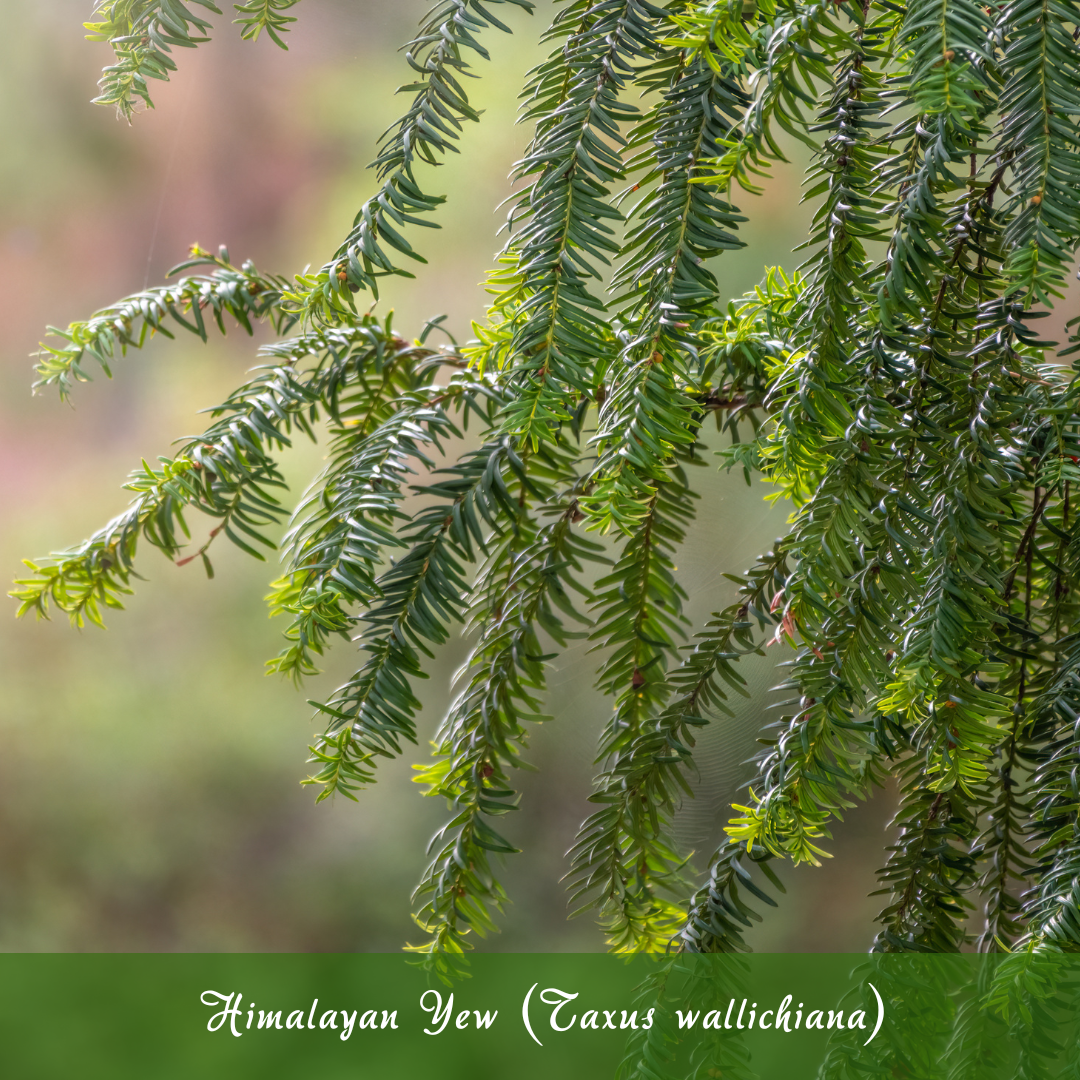
8. Chinese Yew (Taxus chinensis)
- Also known as: Chinese Taxus, Southern Yew
- Bloom time: Spring
- Zones: USDA Zones 7–9
Features
Among the diverse types of yew shrubs, the Chinese Yew is valued for its size, dense foliage, and medicinal properties in warm-temperate regions.
It usually develops to a height of 20 to 30 feet as a small tree or large shrub. Its dense branching habit and smooth, dark green needles provide year-round privacy and interest for landscapes.
The red arils add ornamental appeal, especially in fall. Chinese Yew is also known for producing taxol, a compound used in cancer treatments.
It thrives in warm-temperate climates and provides an elegant, low-maintenance option for hedging, screens, or specimen planting.
How To Grow
Suitable for USDA Zones 7–9, Chinese Yew prefers well-drained, loamy soil and partial shade to full sun. Although it can withstand a range of soil conditions, it prefers moist, slightly acidic soils.
Protect it from excessive heat and drought, especially when young. Mulching keeps roots cool and helps preserve soil moisture. Minimal pruning is needed to maintain shape or remove dead growth.
Due to its tolerance for shearing and adaptability, Chinese Yew works well in formal gardens, woodland edges, or as a foundation plant in southern regions.
9. Sumatran Yew (Taxus sumatrana)
- Also known as: Southeast Asian Yew
- Bloom time: Spring
- Zones: USDA Zones 10–11
Features
Sumatran Yew (Taxus sumatrana) is a tropical yew species native to the high-altitude forests of Southeast Asia, particularly Sumatra, Borneo, and parts of the Philippines.
Among the lesser-known types of yew shrubs, the Sumatran Yew offers a tropical twist with its lush foliage and adaptability to warm climates.
Unlike most temperate yews, it thrives in warm, humid environments. Its dense foliage makes it ideal for ornamental planting in tropical gardens or as a privacy screen.
It produces small, inconspicuous flowers followed by fleshy red arils that attract birds. This species also has medicinal significance and is occasionally studied for taxol production, similar to other yew species.
How To Grow
Sumatran Yew prefers moist, well-draining, slightly acidic soils and thrives in partial to full shade. In USDA Zones 10–11, when temperatures do not decrease much, it thrives in tropical and subtropical climes.
While tolerant of some drought, it grows best with consistent watering, especially during dry periods. To prevent weeds and preserve moisture, mulch the area surrounding the base.
Avoid excessive pruning; shape lightly if needed. Protect from strong winds and avoid salt exposure. Due to its slower growth rate, patience is required, but it is rewarded with long-lasting greenery in shaded tropical landscapes.

10. Yunnan Yew (Taxus yunnanensis)
- Also known as: Yunnan Himalayan Yew
- Bloom time: Spring
- Zones: USDA Zones 7–9
Features
The evergreen shrub or small tree known as Yunnan Yew (Taxus yunnanensis) is indigenous to China's mountainous Yunnan province.
It features soft, dark green needle-like foliage arranged in two rows, with reddish bark and occasional red, berry-like arils that attract birds.
This species thrives in cool, temperate to subtropical climates and is often valued for both its ornamental appeal and medicinal potential due to the presence of taxanes.
Its graceful, upright habit makes it suitable for screening, hedging, or specimen planting in shaded gardens. It is relatively low-maintenance and adapts well to different soil types.
How To Grow
Grow Yunnan Yew in USDA Zones 7–9, in moist, well-drained soil with a slightly acidic to neutral pH. Unlike many other conifers, it can withstand severe shade and prefers partial to full shade.
While drought-tolerant once established, it benefits from regular watering during dry spells. Avoid planting in soggy areas to prevent root rot. Mulch helps retain moisture and protect roots.
Minimal pruning is required, but shaping can be done in late winter or early spring. Shelter from harsh winds improves its growth. Ideal for woodland gardens or shaded urban landscapes.
Conclusion
Yew shrubs offer a diverse range of options for gardeners seeking year-round greenery, elegant structure, and adaptability.
The many types of yew shrubs provide gardeners with versatile, hardy, and elegant options suitable for diverse landscapes and climates.
Whether used for hedging, landscaping, or ornamental value, yews are hardy, adaptable, and timeless. With proper care and placement, these evergreens can thrive in various climates and garden styles, making them a valuable addition to any outdoor space.
I trust you enjoyed this article on Best Types Of Yew Shrubs That Will Transform Your Garden. Please stay tuned for more inspiring guides, helpful tips, and ideas to help you live closer to nature every day.
Take care!
— JeannetteZ
💬 Your Opinion Is Important To Me
Do you have thoughts, ideas, or questions? I’d love to hear from you. Please leave your comments below or email me directly at Jeannette@Close-To-Nature.org.
📚 More Nature-Inspired Reads
Explore more ways to connect with nature, nurture your pets, and live in harmony with the world around you 🌿

